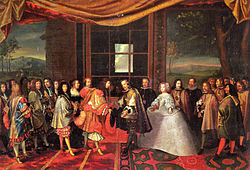Pheasant Island
The Pheasant Island (in Basque: Faisaien uhartea or Konpantzia; in French: Île des Faisans, Île de l'Hôpital or Île de la Conférence) is a river islet located near the mouth of the Bidasoa River, and whose jurisdiction is shared amicably between Spain and France, who agreed to take care of it for six months a year each, and a commemorative day that belongs to both. It is the smallest condominium territory in the world.
The island formerly belonged to the municipality of Fuenterrabía (Guipúzcoa), but is currently administered by the City Council of Irún (until the Franco-Spanish treaty of 1856) since the latter separated from the former in 1766.
Its current surface area is approximately 6,820 m² (0.7 ha) and is stabilized thanks to the protection work carried out on it.
France and Spain share the sovereignty of the island, with France assuming its administration during the months of August, September, October, November, December and January. Spain, for its part, controls the island in February, March, April, May, June and July.
History and etymology

This area was mainly a territory populated by pre-Roman peoples of Basque origin, in whose vicinity Oiasso (present-day Irún) was located. It later became part of the Roman Empire, with the conquests of Gnaeus Pompey Strabo and Pompey the Great, without registering battles with the Basques. However, these were used to subjugate the peoples that occupy the current provinces of Guipúzcoa, a strip of the current Vizcaya and an even smaller extension of the current Álava, territories inhabited by Várdulos, Caristios and Autrigones, which were subjugated. with auxiliary infantry made up of Basques. In the reorganization of Hispania carried out by Augustus (27-7 BC), the Vascons are in the legal convent of Caesaraugusta, while the Várdulos, Caristios and Autrigones are in that of Clunia. For an almost anecdotal period of less than 50 years, this territory belonged to the Hispanic March of the Carolingian Empire, being quickly absorbed by the expansion of the Kingdom of Navarre. Since 1198 these territories belonged to the Kingdom of Castile, occasionally disputing with the Kingdom of Navarra, which was finally absorbed by the Crown of Castile in 1512 after the conquest commanded by the Duke of Alba of Navarra. During the War of Independence it was occupied by France but since the Treaty of Bayonne (1856), it has been shared between Spain and France, specified in a convention of 1901.
Many names have been attributed to this island. In Roman times it was called in Basque “pausu” or “pauso” ("step", in Spanish)[citation required] because of the toll that had to be paid to transit between Aquitania and Hispania, and from here comes the name "Island of the Paussans", which the French changed first to "Faussans" and then to "Faisans", although in French it was mostly called "Île de l'Hôpital»; In Spanish, by the translation of "Faisans", it bears the name "Pheasant Island", which is the most used today. In Basque there are still those who call it "Konpantzia", its origin being, without a doubt, the conferences that were held on the island during the XVII century.
Among the many historical events that took place on this island, the most important was the signing of the Peace Treaty of the Pyrenees after twenty-four conferences held between Luis de Haro and Cardinal Mazarin in 1659. The Treaty was ratified for the engagement contracted between Louis XIV and the Infanta María Teresa of Austria, on June 10, 1660.
In the center of the island stands a monolith with an inscription commemorating these events. In addition, exchanges of hostages and deliveries of marriageable princesses have taken place, among other diplomatic events. The painter Diego Velázquez came here to prepare one of these events.
The smallest condominium in the world
Since the end of the 19th century the jurisdiction is rotating for periods of six months. Pheasant Island was during long a major source of conflict between Spanish and French fishermen, who carried out their work on both banks of the Bidasoa River, which serves as a natural border between both countries. With the aim of avoiding these confrontations and preventing the islet from becoming unlegislated land, the two states decided to divide its jurisdiction for six months a year.
This makes it also known by the names of Conference Island or Diplomats Island, constituting the smallest condominium in the world.
This island was also where the Treaty of the Pyrenees was signed on November 7, 1659, which put an end to the war between Spain and France that had begun in 1635. From that moment on, the Pyrenees They became the natural border between the two countries.
There, after more than twenty-four meetings between the ministries of Madrid and Paris, Don Luis de Haro and Cardinal Mazarin, the marriage of Louis XIV with María Teresa of Austria, Infanta of Spain, was also agreed upon; marriage agreement that a year later, in 1660, both monarchs, Louis XIV and Philip IV, would ratify on the same island.
Contenido relacionado
511
491
145